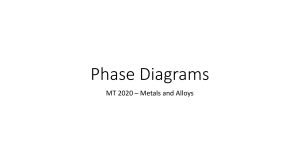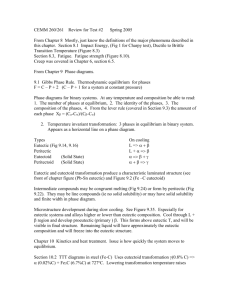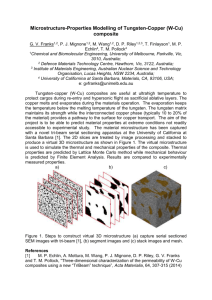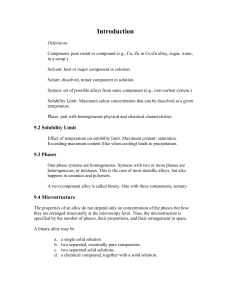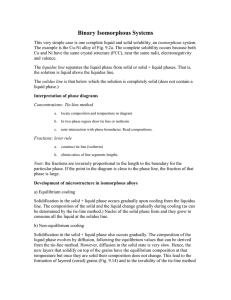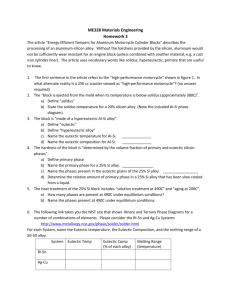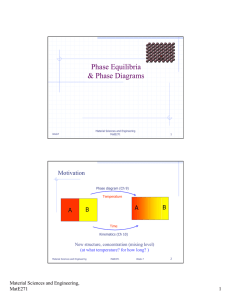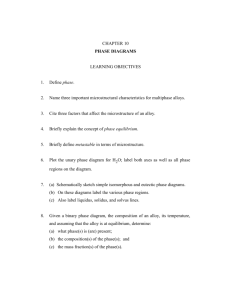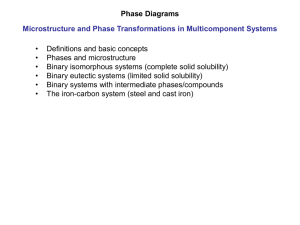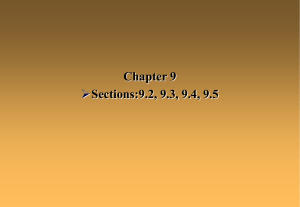Phase Diagrams
advertisement
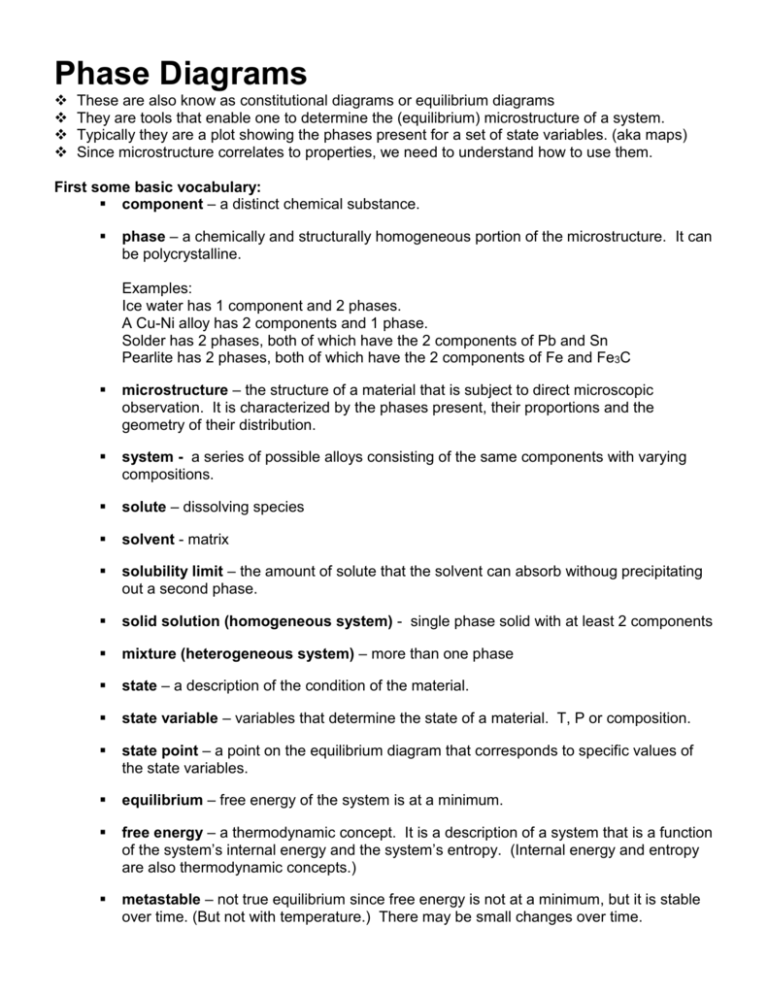
Phase Diagrams These are also know as constitutional diagrams or equilibrium diagrams They are tools that enable one to determine the (equilibrium) microstructure of a system. Typically they are a plot showing the phases present for a set of state variables. (aka maps) Since microstructure correlates to properties, we need to understand how to use them. First some basic vocabulary: component – a distinct chemical substance. phase – a chemically and structurally homogeneous portion of the microstructure. It can be polycrystalline. Examples: Ice water has 1 component and 2 phases. A Cu-Ni alloy has 2 components and 1 phase. Solder has 2 phases, both of which have the 2 components of Pb and Sn Pearlite has 2 phases, both of which have the 2 components of Fe and Fe3C microstructure – the structure of a material that is subject to direct microscopic observation. It is characterized by the phases present, their proportions and the geometry of their distribution. system - a series of possible alloys consisting of the same components with varying compositions. solute – dissolving species solvent - matrix solubility limit – the amount of solute that the solvent can absorb withoug precipitating out a second phase. solid solution (homogeneous system) - single phase solid with at least 2 components mixture (heterogeneous system) – more than one phase state – a description of the condition of the material. state variable – variables that determine the state of a material. T, P or composition. state point – a point on the equilibrium diagram that corresponds to specific values of the state variables. equilibrium – free energy of the system is at a minimum. free energy – a thermodynamic concept. It is a description of a system that is a function of the system’s internal energy and the system’s entropy. (Internal energy and entropy are also thermodynamic concepts.) metastable – not true equilibrium since free energy is not at a minimum, but it is stable over time. (But not with temperature.) There may be small changes over time. Binary Isomorphous Phase Diagrams have complete solid solubility in the solid state. (P is at 1 atm.) a b c T Tm B L(single phase region) liquidus L+ (2 phase region) solidus Tm A (single phase region) 100% A 0% B 100% B 0% A increasing wt% B We want to determine the microstructure. These are the questions: 1. What phases are present? 2. What are their compositions? 3. How much of each phase is there? 4. How are they distributed? Here is how to get the answers: 1. Go to the state point. 2. Use the tie line. (isotherm) 3. Use the lever rule. 4. Go through an equilibrium microstructural development What will be the microstructure of an alloy at room temperature if cooled under equilibrium conditions for the compositions a, b and c? a b c Note: Non-equilibrium micro-structural developments will result in a cored microstructure that will need homogenization heat treatment. Binary Eutectic Phase Diagrams have limited solid solubility. T 1 2 3 4 L +L +L + A B VOCABULARY liquidus solidus solvus eutectic point (“fully melt”) eutectic temperature eutectic composition eutectic isotherm Note: an isotherm will always alternately cross over single and two phase regions. eutectic reaction invariant point eutectic microstructure eutectic primary microconstituent What is the resulting microstructure at room temp for the cooling of compositions 1-4? 1 2 3 4 Other Concepts: invariant state point no state variable can change without changing the phases present. invariant reaction the reaction that occurs when the temperature is changed at an invariant state point. Gibbs Phase Rule P+F=C+N terminal solid solutions intermediate compounds intermediate solid solutions (intermediate phases) congruent transformations (congruent melting) transformations in which no change in composition for any phase is involved. e.g. allotropic transformations, melting of pure materials incongruent transformations (incongruent melting) the transformation involves a resulting phase that has a different composition than the phase(s) from which it came. e.g peritetic reactions The Iron-Iron Carbide Phase Diagram metastable ferrite - Fe (bcc) There is also Fe which is also bcc but with a larger a. It is not commercially important. austenite - Fe (fcc) cementite – Fe3C a hard and brittle intermediate compound. iron - pure Fe with < 0.008% C steel – iron with anywhere from 0.008% – 2.14% C. (usually steel has < 1% C) cast iron – Fe with anywhere from 2% - 6.7% C. (usually about 4.5%C) Si is often added to accelerate the cementite decomposition. eutectoid steel pearlite eutectoid ferrite eutectoid cementite hypoeutectoid steels proeutectoid ferrite hypereutectoid steels proeutectoid cementite What will be the microstructure of a steel under equilibrium cooling? eutectoid hypoeutectoid hypereutectoid What are some of the effects if cooling is non-equilibrium? 1. The phase changes may occur at different temperatures. 2. There may be nonequilibrium phases that do not appear on the Phase diagrams. What will be the effects on the microstructure of other (than Carbon) alloying elements? 1. They can alter the position of the phase boundaries. 2. The shape of the phase fields may be altered.

